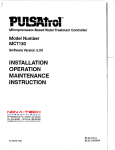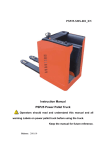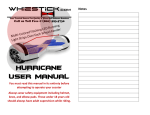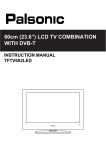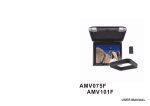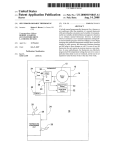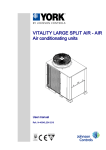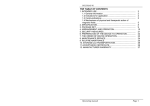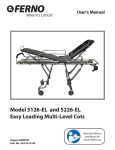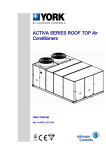Download User`s Manual - Treasure Hunters Online
Transcript
Best Friend Mobility ® Owner’s Manual For Medium-Size Wheelchair (40-60 lbs) Best Friend Mobility ® 7335 Royal Harbour, Oolteweh, TN 37363 Phone: (423) 299-8503 • Fax: (423) 443-4329 Customer: Dear Pet Owner and Valued ly and g with the attached assemb The following guidelines, alon use of your ist you in gaining the best fitting instructions, will ass dog wheelchair. hind legs, -weight bearing on his/her If your pet is fully NON wheelchair ditioning your pet to his/her we recommend gradually con take will exercise are attempted. It before prolonged periods of front the in to become strong enough about 2-weeks for your pet chair. new her non-weight bearing in his/ legs to compensate for the king wal , cise exer pet with ten minutes of We suggest starting your to n hioi fas al leash, attached in a norm over hard surface. Using a eat twice front harness is advised. Rep the your pets collar or to s a day. time e , then increase to thre daily for the first few days amount of the d, rate cise is well tole Once this amount of exer ina. ch your pet's stam time can be extended to mat , we back to walking on their own ing com are For pets that exercise. e uat adeq get to r r cart in orde recommend daily use of thei ourage them from walking but rather enc This will NOT prevent them Table of Contents ® ilitation Aids Best Friend Mobility Rehab Best Friend Mobility ® Section 1: Product Information . . . . . . . . . . p.01 Section 2: How To Measure . . . . . . . . . . . . p.02 Section 3: Parts List . . . . . . . . . . . . . . . . . . p.03 ALONE IN THE CART DO NOT LEAVE YOUR PET Section 4: Parts Identification . . . . . . . . . . . p.04 ber provided please call us on the num If you have any questions o of your y receiving pictures or a vide in this manual. We also enjo fitting evaluation. for our reference and also pet in his/her wheelchair down from the side, rear, and looking Photos should be taken from adjustments all us to assist you in making above. These photos will help its from fit r pet will gain the most bene needed to ensure that you Section 5: Wheelchair Use . . . . . . . . . . . . . p.05 Section 6: Care & Maintenance . . . . . . . . . p.06 Section 7: Fitting The Dog . . . . . . . . . . . . . p.07 Section 8: Troubleshooting . . . . . . . . . . . . . p.08 to do so. new mobility. with using a and your pet are unfamiliar We realize that both you . help for hesitate to contact us dog wheelchair, so do not ® dog wheelchair. ility a Best Friend Mob Thank you for purchasing your , photos and videos of how ries sto k, bac We love receiving feed wheelchair. pet is doing in his/her new Sincerely, t Tim Cantrell - Vice Presiden (423) 443-4329 : Fax • 3 850 299Phone: (423) Copyright © 2009 Best Friend Mobility® m.r09; Revised December, 2009 Section 1: Product Information This Best Friend Mobility® is made to fit any dog from 40-60lbs. This cart is adjustable in length, height and width, so it can fit 99% of all dogs 40-60lbs. Section 2: How To Measure The chart below is for assistance in measuring your pet. These measurements can help you to adjust the cart to the optimal dimensions for your pet. This dog wheelchair is lightweight 3.5lbs, responsive, sturdy, and manueverable enough to handle even the most active of pets. Measuring Your Dog for the Best Friend Mobility® This Wheelchair is made of high quality parts and sturdy, lightweight materials; powder-coated 6061-t6 aluminum and machined HDPE plastic, with stainless steel and black alloy screws. b Includes deluxe wheels, made of a tough, lightweight plastic with knobby, polyurethane tires and precision-sealed ball bearings. a e g f c d The supportive rear leg rings, made of plastic-coated steel cable covered with a NBR-PVC closed-cell foam, offer full, flexible support and will not absorb waste or dirt. The dog can still go to the bathroom comfortably in the rear harness. a. Width from shoulder to shoulder b. Width from side to side at rump c. Top of shoulder to ground d. Groin to ground e. Front of back leg to rear of front leg f. Width of front leg g. Width of rear leg w. Weight weight Tips for Measuring Your Dog: Specs: • Measure your dog in an upright & natural standing position. Keep dog’s body level while measuring precisely and accurately. Get a second person to help if steadying the dog is needed. • Lightweight adjustable aluminum frame (non-rust) • Measurements of parts ‘a’ & ‘b’ should be straight across. Do not measure on a curve, as this will alter the actual measurements. • Non-rust stainless or galvanized hardware • Your veterinarian may be able to assist you, especially in weighing your dog. • Deluxe space age NBR-PCV covering steel cables rear harness • Designed and tested by k9 Orthopaedic surgeon • Easy to adjust height, length, and width to fit 99% of dogs • Pet can use the cart for assisted walking or zero weight bearing on rear legs • Allows pet to use bathroom while in cart • All terrain polyurethane wheels with precision-sealed ball bearings • Easy clip on function of front harness 1 Best Friend Mobility® is good for: • Hip Dysplasia • Arthritis • Rehabilitation • Nuerological problems like osteomyelitis or degenerative myelopathy • Fractured spine/back • Rear limb amputee • Ligamentous injury like PCL or ACL • Thoracic or Lumbar disc injury • Any other condition that results in rear leg pain or weakness 2 Section 3: Parts List Section 4: Parts Identification 1 - Left Sidearm Connector x1 9Sidearm Endcap x2 17 - Mushroom Head Bolt (Short) x2 25 - Cap Nut x2 2 - Left Sidearm Connector x1 10 Endcap Medium x2 18 - Adjustable Hex Screw x4 26 Front Harness x1 3 - DC01B Wheel Bar x2 11 Wheel Bar Endcap x2 19 - Adjustable Hex Screw x4 27 - Rear Leg Straps x1 4 - Right Rear Harness Bar x1 12 Endcap Large x2 20 - Star Washer x4 28 PVC Rear Harness x1 Parts Identification Numbers: 5 - Left Rear Harness Bar x1 21 - Star Washer x4 13 Spacer Widget x2 6Sidearm x2 14 - Rivet (Part of Frame) 22 - Flat Washer x4 7 - DC07 Wheels x2 15 - Carriage Bolt x2 23 - Wheel End Bolt x2 8 - Wheel Bar Thumb Screw x2 16 - Mushroom Head Bolt (Long) x2 24 Nut x4 3 29 - Steel Cable Rear Harness x2 30 - Rear Harness Strap x2 32 Screws (Repeats????) x4 1. 2. 3. 4. 5. 6. 7. 8. 9. 10. 11. 12. 13. 14. 15. 16. 17. 18. Left Sidearm Connector Right Sidearm Connector Right Wheel Bar Right Rear Harness Bar Left Rear Harness Bar Sidearm Wheel Bar Thumb Screw Endcap Sidearm Endcap Wheelbar Endcap Endcap Large Spacer Widget Carriage Bolt Mushroom Head Bolt (Long) Mushroom Head Bolt (Short) Adjustable Hex Screw Adjustable Hex Screw PVC 19. 20. 21. 22. 23. 24. 25. 26. 27. 28. 29. 30. 31. 32. 4 Adjustable Hex Screw Washer Washer Locknut Cap Nut Bolt Head Rear Harness Sidearm Rear Harness Strap Rear Harness Strap Front Harness Rear Leg Straps Wheel Spacer Widget Section 5: Wheelchair Use If your dog is completely non-weight bearing on the hind legs and will be using the leg straps, then it is normal for the front legs to require some strengthening time for compensation of the rear legs and full comfortable use of the Best Friend Mobility® wheelchair. Please allow about 2-weeks for full strengthening of the front limbs; you can strength train your dog with partial weight bearing assist using a leash connected to the front harness. Is your dog too weak to stay on his front legs while in the Best Friend Mobility®, from being overweight or being inactive? You may need to attach a leash to the front harness to help support his weight until your pet gets conditioned. If your dog’s front legs do not get strong enough within a few short weeks, he may need something other than what the Best Friend Mobility® can provide. Make sure your dog isn’t always trying to lay down or not able to hold his own weight after a couple of weeks. He may even roll backwards, even with continued use. These are all signs that his front legs aren’t strong enough to use the Best Friend Mobility®. Section 6: Care & Maintenance Keep your Best Friend Mobility® clean... your dog will surely appreciate it and ride with pride. Wipe down aluminum surfaces with warm soapy water using a soft cloth, such as a microfiber cloth or a cotton rag. Rinse & dry. Frequently check the tightness of the bolts and screws and retighten if too loose. Adjust straps if they also become too loose. Remember to hose or wipe down the tires, to keep it from tracking dirt. Check the tire pressure every so often and inflate when needed. To reduce bounce and increase traction, slightly underinflate the tires (from recommended PSI) to make the unit a more comfortable ride. Do not underinflate too much. Please wash the sling, harness and straps in cool water and hang them to dry. You may want to use a perfume-free detergent so that your pet will not have any skin irritations. You might also want to try some odor neutralizers to get the smell out of the harnesses. However, your dog may initially move backwards instead of forward in the Best Friend Mobility®. This is an unfamiliar situation and your dog is “backing out.” Your dog will eventually become comfortable and begin to move forward with some assurance and encouragement. Get your Best Friend Mobility® wet! Your Best Friend Mobility® is mostly made of aluminum, which will not rust. If you use the Best Friend Mobility® in salt water, rinse it off after use, otherwise, getting the unit wet will not damage it. If you are near a beach, don’t forget to rinse off the sand and dirt from moving parts of the Best Friend Mobility®. If the traction on the wheels of your dog’s Best Friend Mobility® are poor, there may be an easy solution. You may want to check the tire pressure, remembering to keep the pressure at slightly below the required PSI. Make the the wheels are also spinning freely. If the wheels track to one side more than the other, it may simply be how your dog walks naturally. You may notice his walk more due to his new wheelchair, however, he or she will get used to the Best Friend Mobility® and be able to compensate in due time. Also make sure that your dog is centered from side to side and adjust straps if neccessary. Check your dog’s weight balance and height to see if the Best Friend Mobility® is suitable for him or her to use (See Section2: How To Measure, p.2). 5 6 Section 7: Fitting Dog Into Chair. 1. Place front harness on Pet guiding over head/neck and under front legs (adjust for comfort and firmness) 2. Guide rear legs into rear harness and adjust for comfort and firmness. 3. Bring up cart behind pet 4. Snap front harness into sidebar snaps, and rear harness into rear snaps 5. Adjust lift of rear harness according to pet comfortable weight bearing 6. If pet is non-weight bearing on rear legs, use leg straps and secure on rear fastenings. Be sure rear legs can rest at relaxed angle. Fitting your dog to the Best Friend Mobility® The two sidearms of the frame should be a couple of inches above the top and parallel to the dog’s back. However, the height may vary depending on your dog’s build (Shoulders being lower than the hips). When the position of the harnesses, according to your dog’s length, is set properly to the sidearms, the front legs should, in no way, rub against the sidearms while your dog is walking. The front harness should be placed comfortably behind your dogs front legs and the rear leg slings should be adjusted for a comfortable fit. Do not raise at an angle which is too unnatural for your dog. Make sure to place the front strap to sit slightly above center of the chest. Do not allow it to press against the throat or rest below the center of the chest as it may be harmful to your pet. Adjust all the straps to be snug but do not overtighten. Also, check your dog’s weight balance and height to see if the Best Friend Mobility® is suitable for him or her to use (See Section2: How To Measure, p.2). 7 8 Section 8: Troubleshooting Adjusting your dog’s Best Friend Mobility® and making sure it is a proper fit will allow it to be a safe vehicle for your dog. Avoiding misuse and common errors will allow your dog to quickly start enjoying the use of the Best Friend Mobility®. Common Problems: The angle of the rear leg slings are too high and the slings do not extend beyond your dog’s rear. Make sure to keep the legs at a comfortable and natural height. Why does the wheelchair tip backwards? The frame should be a couple of inches above your dog’s back. Adjust the front posts. Make sure the length is proper for your dog. Adjust sidearms and/or straps. Check your dog’s front harness making sure the front strap is centered across his or her chest. Adjust the straps and see if this stop the wheelchair from tipping. Checking for weight balance is crucial. Make sure the wheel position is adjusted toward the rear of the connector blocks. Make sure all your straps and sidearms are adjusted to the new position accordingly. Keep in mind previous instructions. Why does the wheelchair tip forwards? The frame should be a couple of inches above your dog’s back. Adjust the front posts. Check your dog’s front harness making sure the front strap is centered across his or her chest. Adjust the straps and see if this stop the wheelchair from tipping. Checking for weight balance is crucial. Make sure the wheel position is adjusted toward the middle or front of the connector blocks. Make sure all your straps and sidearms are adjusted to the new position accordingly, keeping in mind previous instructions. 9 If the front harness is too high it will cause your dog to lose his breath, as it presses against his or her throat while walking. If the front harness is too low it will cause your dog to take shorter strides. Contacting Us: After having read all the directions, if you have any further questions regarding the use of the Best Friend Mobility® wheelchair, please contact us: Best Friend Mobility ® 7335 Royal Harbour, Oolteweh, TN 37363 Phone: (423) 299-8503 • Fax: (423) 443-4329 "We love and appreciate pictures and video of your dog in his/her wheelchair. Please email any pictures to your dealer whom you purchased the dog wheelchair from." 10








